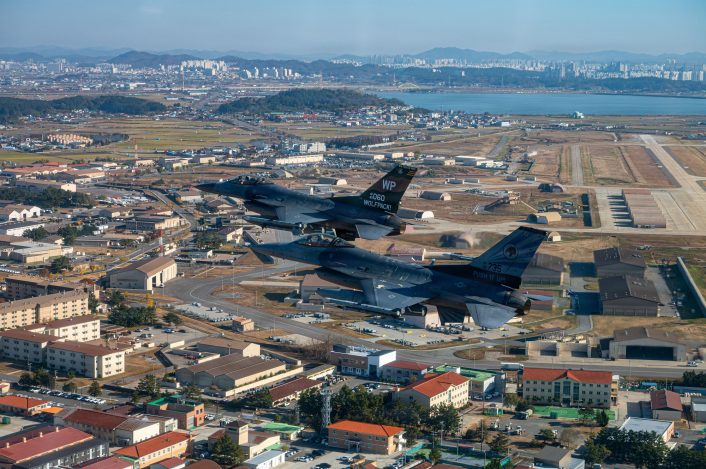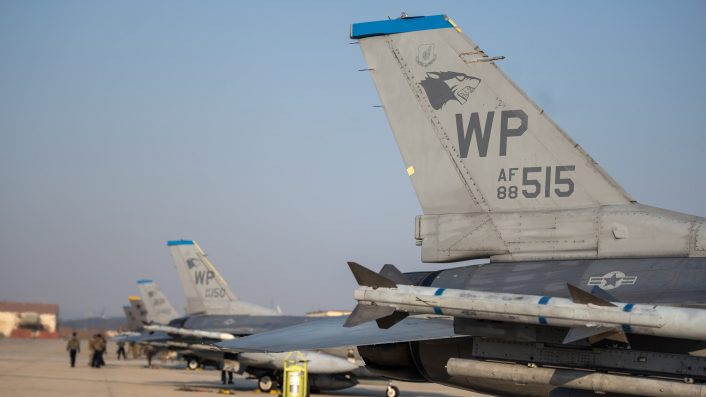Building up on the previous Super Squadron test, the Seventh Air Force launched a second phase and added another squadron with 31 F-16s at Osan.
The F-16s of the U.S. Air Force’s 35th Fighter Squadron “Pantons,” assigned to Kunsan Air Base, South Korea, arrived at Osan Air Base on Nov. 19 and 21, 2025, to launch the second phase of the Super Squadron test. In fact, building up on the similar effort launched last year, the Seventh Air Force extended the experiment for a second phase and added another squadron with 31 F-16s at Osan.
“This movement is about strengthening the way we fight,” said U.S. Air Force Lt. Col. Joseph Basala, 35th Fighter Squadron commander. “By operating from Osan, our team gains new opportunities to integrate with partners, adapt to unfamiliar environments, and sharpen the skills we need to answer the call at a moment’s notice. This effort directly improves our readiness and reinforces our commitment to the defense of the peninsula.”
The aircraft, along with personnel from Kunsan Air Base, are temporarily re-assigned to Osan in support of the initiative. The goal is to test new ways to organize, deploy, and sustain fighter aircraft across the Indo-Pacific theater, increasing combat power while maintaining readiness across the Republic of Korea.

Super Squadron Phase II
During the Super Squadron Phase II experimentation, the 35th FS will conduct training and integrate with Osan’s 51st Fighter Wing. This will support the ongoing testing period of manpower, maintenance, and operations concepts that enable fighter squadrons to generate more combat power without permanently relocating forces, explains the service.
“The Super Squadron test gives us a real-world opportunity to explore how we can fight more efficiently with greater flexibility and resilience,” said U.S. Air Force Col. Ryan Ley, 51st Fighter Wing commander. “Hosting the Pantons strengthens our combined readiness and enhances the airpower available to defend the Republic of Korea. This effort benefits the entire peninsula and reinforces the strength of our alliance.”
The Air Force previously said 31 additional F-16s and approximately 1,000 Airmen would transfer to Osan AB from Kunsan AB to establish the second squadron. The movement was of a different magnitude compared to the first phase, which only included the movement of nine F-16s and 150 Airmen, adding new challenges that will provide additional data to the service.

This was also mentioned by the Seventh Air Force’s press release earlier this year, which said the first test was launched to evaluate if the super squadron concept would maximize combat effectiveness when considering sortie generation, maintenance, manpower, and logistics requirements, and now the second phase will continue to assess those areas at a larger scale, as the increased numbers of aircraft and Airmen fully test limitations.
The decision to continue with a second phase arrived while still about halfway through the first one, started in October 2024, and was based on the data collected so far that has been analyzed. The Seventh Air Force was thus granted the approval to continue the experiment for another year, further expanding its scope.
“The past months of data reveal that we’re on the right track and the consolidated, larger unit has shown some increases in readiness and combat capability, while also exposing some challenges,” said Lt. Gen. David Iverson, Seventh Air Force commander. “With this success we’re now expanding the scope, by consolidating the F-16s in Seventh Air Force at Osan, to further determine if the super squadron construct is the right path for future airpower generation here in Korea.”

Obviously, with the second phase, Kunsan will see most of its Vipers leave the base, with only a handful remaining there. However, the service says the 8th FW will continue to operate as a primary exercise and rotational force bed-down location for U.S. air component forces in ROK.
This way, the unit will maintain active flightline operations and facilities, in addition to maintaining war reserve material and munitions at multiple locations across South Korea. This mission is a critical part of Seventh Air Force’s task of providing credible combat airpower in the defense of the ROK-U.S. Alliance, says the service.
Super Squadron Phase I
In August 2024, the Seventh Air Force announced the launch of the Super Squadron test, which started in October and was initially set to last an entire year. The 36th Fighter Squadron gained nine F-16s, drafted from the 35th and 80th Fighter Squadrons at Kunsan Air Base, bringing the total of its assigned aircraft from 22 to 31.

The Vipers (as the F-16s are nicknamed by their crews) were transferred with 150 aircrew and combat support personnel accompanying. While at Osan, the additional aircraft took part in multiple exercises with the 36th FS.
“Osan was chosen as best able to support the housing and support needs of the Airmen required to execute the Super Squadron test, having recently supported similar personnel requirements during Kunsan’s runway construction project in 2023,” said Lt. Col. Karl Wiest, a spokesperson for Gen. Allvin. Osan is also home of the Seventh Air Force’s headquarters.









